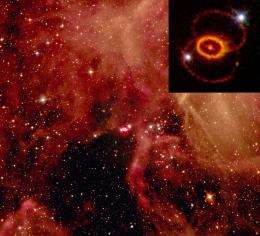Shedding new light on supernova mystery

(PhysOrg.com) -- Physicists have a new theory on the mysterious mechanism that causes the explosion of massive, or core, stars. These ‘Type II supernovae’, the term given to exploding core stars, are huge and spectacular events – intriguing because for a short time they emit as much light as is normally produced by an entire galaxy. In fact, the enormous amount of energy they release is second only to the Big Bang itself. While there is general agreement on how the collapse of a core star begins, how the energy escapes from the star (the process that causes the explosion) is not fully understood. A paper published in Physics Letters B (November 3, 2011) offers a new theoretical explanation.
A core star collapses when it runs out of the nuclear fuel it depends on and folds in on itself in less than a second under its own huge weight. This process releases enormous amounts of gravitational energy, causing an explosion. A small fraction of the total energy released during a supernova Type II (collapse of a lone massive star that burns energy through fusion), is emitted as light, the kinetic energy of the exploding stellar envelope is 10 times greater again, but by far the most energy is carried away by neutrinos. It is by studying these neutrinos (among the most difficult particles to detect) that physicists have come to general agreement that gravitational collapse does start the Type II supernova process.
Less understood is whether the outgoing pressure wave causing the explosion - that soon becomes a huge shock wave - travels all the way out and ejects the outer part of the star. Simulations have shown that the prompt shock stalls at distances of about 300 km from the centre because of the immense energy required to keep its momentum. Further simulations have found that the shock could re-start if the electrons could absorb a small amount of energy - about 1% of the neutrino energy available.
Physicists at the University of Aberdeen, STFC’s Rutherford Appleton Laboratory, the University of Strathclyde and the Instituto Superior Técnico in Lisbon suggest in Physics Letter B that the solution to the Type II supernovae mystery might lie in a fundamental field long proposed by physicists to answer many important questions. They claim that a component of gravity called the ‘scalar gravitational field’ may be the driving force behind the release of energy that causes the star to finally explode. The existence of scalar fields are predicted but have not yet been detected.
“Scalar fields, unlike electromagnetic fields do not have a direction. They are needed to explain inflation in the early universe and dark energy in cosmology. They are also being hunted at CERN’s Large Hadron Collider as the Higgs particle, giving rise to the origin of mass. In our case, we believe it is responsible for accelerating particles”, said Professor Bob Bingham from STFC and the University of Strathclyde.
“The theory is that emission of these scalar gravitational waves from the neutron core of a collapsing heavy star may re-energise the stalled shockwave”, added Dr Charles Wang from the University of Aberdeen.
More information:
These scientists in the UK and Portugal have recently analysed the nonlinear coupling (a process by which energy is transferred from one system to another) to this scalar gravitational field. They found that under extreme conditions with strong time-varying gravity such as may be found in the interior of a newly-born neutron star, the scalar gravitational field may be stimulated by a parametric instability
(a form of coupling between energy sources). Parametric instabilities were initially studied by Lord Rayleigh over a century ago.
The theory is that emission of these scalar gravitational waves from the neutron core of a collapsing heavy star may re-energise the stalled shockwave. This theoretical possibility for a new mechanism, - a potential solution to the type II supernova mystery is in Physics Letters B, Vol 705 (2011), Pages 148 – 151. dx.doi.org/10.1016/j.physletb.2011.09.111
Provided by Science and Technology Facilities Council


















